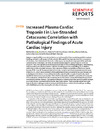Identificador persistente para citar o vincular este elemento:
https://accedacris.ulpgc.es/jspui/handle/10553/77720
| Título: | Increased plasma cardiac troponin I in live-stranded cetaceans: correlation with pathological findings of acute cardiac injury | Autores/as: | Câmara, Nakita Sierra Pulpillo, Eva María Fernández Rodríguez, Antonio Jesús Arbelo Hernández, Manuel Antonio Andrada Borzollino, Marisa Ana Espinosa De Los Monteros Y Zayas, Antonio Herráez Thomas, Pedro Manuel |
Clasificación UNESCO: | 3105 Peces y fauna silvestre 310907 Patología |
Palabras clave: | Cardiomyopathies Diagnostic markers Stranded cetaceans |
Fecha de publicación: | 2020 | Publicación seriada: | Scientific Reports | Resumen: | Capture myopathy (CM), is a syndrome that occurs as the result of the stress during and after capture, handling, restraint, and transport of wild animals. Although CM has been described for many species of cetaceans, characterization of the acute cardiac injury - an important component of this syndrome - are still scarce. In this study, we firstly estimated a normal range for cardiac troponin I (cTnI) on cetaceans. Here, through biochemical analysis (especially of cTnI) and histopathological, histochemical, and immunohistochemical correlations with decreased troponin immunolabelling, we studied the cardiac injury in live-stranded cetaceans. Nine cetaceans which stranded alive on the Canary Islands (January 2016 - June 2019) were included in this study. Sampled individuals presented elevated values of plasma cTnI, which were correlated to histopathological lesions comprised of vascular changes and acute degenerative lesions. Immunohistochemically, injured cardiomyocytes showed a decreased intrafibrillar troponin immunoreaction. This is the first attempt to establish a normal baseline range for cTnI in cetaceans, and the first study comparing plasma biomarkers values with histopathological and immunohistochemical findings. This approach allowed us to demonstrate the degree of cardiac damage as a result of injury, consistent with ischemia–reperfusion lesions. The knowledge gained here could improve decision-making procedures during stressful situations, mainly in live-strandings, handling, and rehabilitation, thereby reducing the mortality of cetaceans. | URI: | https://accedacris.ulpgc.es/handle/10553/77720 | ISSN: | 2045-2322 | DOI: | 10.1038/s41598-020-58497-3 | Fuente: | Scientific reports [EÏSSN 2045-2322], v. 10, article number 1555 |
| Colección: | Artículos |
Los elementos en ULPGC accedaCRIS están protegidos por derechos de autor con todos los derechos reservados, a menos que se indique lo contrario.
